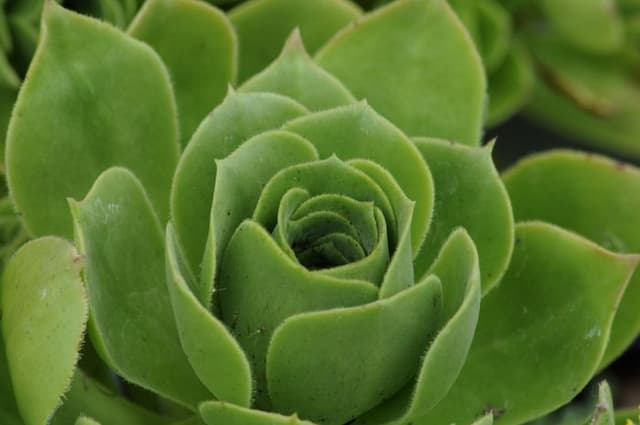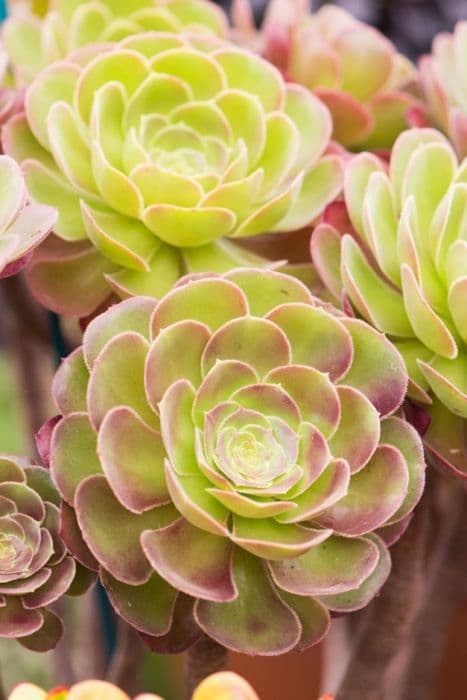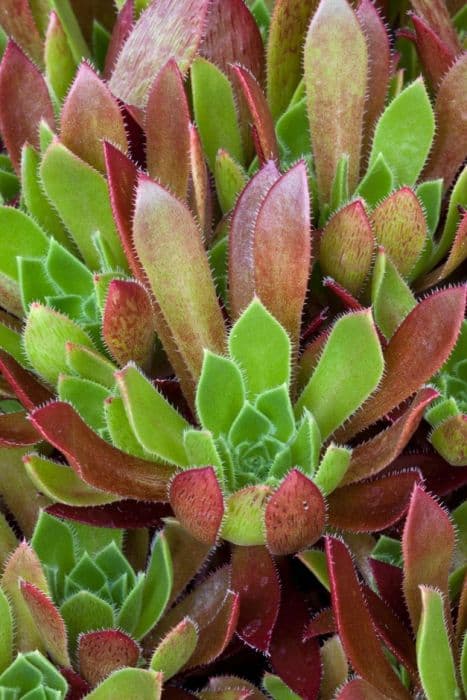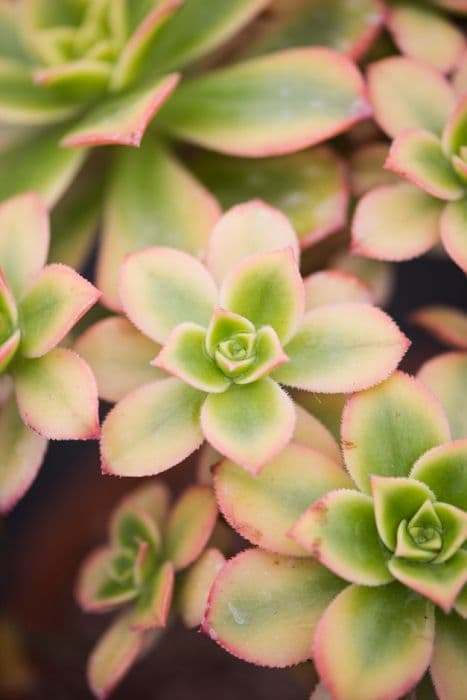Stonecrop Hylotelephium spectabile Brilliant Group

ABOUT
The Hylotelephium spectabile Brilliant Group, commonly known as the Stonecrop, is a perennial plant known for its hardy nature and ornamental appeal. The Stonecrop possesses succulent leaves that are thick, fleshy and retain water. These leaves are often a gray-green color and may have a slight bluish tint or a waxy coating that gives off a frosted appearance. The plant has a robust, upright growth habit, forming clumps of foliage. Its leaves are commonly arranged in a whorled pattern, which adds to the plant’s lush, full look. During the blooming season, the Stonecrop becomes particularly striking as it produces a profusion of tiny, star-shaped flowers. These blooms are densely packed in large, dome-shaped clusters. The flowers themselves are typically a vibrant pink or even a deeper, magenta hue which adds a dramatic splash of color to gardens. The Stonecrop's flowers are not only a beautiful sight; they also attract a range of pollinators such as bees, butterflies, and other beneficial insects. As the season progresses, the color of the flowers may deepen, and in the late season, the seed heads provide additional visual interest. They may remain on the plant through the winter, offering a stark contrast to the bare garden. The Stonecrop's distinctive look, characterized by its fleshy leaves and bold flower clusters, makes it a favored choice for rock gardens, borders, and as a ground cover in different landscapes.
About this plant
 Names
NamesFamily
Crassulaceae
Synonyms
Showy Stonecrop, Ice Plant, Butterfly Stonecrop, Brilliant Stonecrop
Common names
Sedum spectabile, Sedum spectabile Boreau, Hylotelephium spectabile (Boreau) H. Ohba, Sedum spectabile var. neomexicanum Clover, Sedum spectabile var. spectabile.
 Toxicity
ToxicityTo humans
Stonecrop, as it is commonly known, is not considered highly toxic to humans. However, if ingested in significant amounts it could potentially cause mild gastrointestinal upset. Symptoms may include nausea, vomiting, or diarrhea. It is always advisable to keep plants away from young children who may inadvertently ingest plant materials.
To pets
Stonecrop is generally considered to be of low toxicity to pets as well. However, if a pet ingests a large quantity of this plant, it may experience mild vomiting or diarrhea. It is important to prevent pets from eating plants since individual sensitivity can vary, and to keep an eye on them for any signs of distress after ingesting plant material.
 Characteristics
CharacteristicsLife cycle
Perennials
Foliage type
Deciduous
Color of leaves
Green
Flower color
Pink
Height
1-2 feet (30-60 cm)
Spread
1-2 feet (30-60 cm)
Plant type
Succulent
Hardiness zones
3
Native area
Asia
Benefits
 General Benefits
General Benefits- Attracts Pollinators: The plant produces flowers that are highly attractive to butterflies, bees, and other pollinating insects, enhancing biodiversity.
- Low Maintenance: Once established, Sedum (the common name of Hylotelephium spectabile) is drought-tolerant, requiring minimal water and care.
- Erosion Control: Sedum has a mat-forming habit that helps stabilize the soil and prevent erosion on slopes or in garden beds.
- Visual Interest: With its vibrant flowers and fleshy leaves, Sedum provides aesthetic appeal and adds color to gardens from late summer into fall.
- Winter Interest: Even after the growing season, dried Sedum flower heads can add texture and interest to the winter landscape.
- Easy Propagation: Sedum can be easily propagated from cuttings or division, making it a cost-effective way to expand your garden or share with others.
- Versatility: It is suitable for a variety of garden settings, including borders, rock gardens, and containers.
- Drought Resistance: Sedum is well adapted to withstand periods of dry weather, making it a great choice for water-wise gardens.
- Cold Hardy: The plant is capable of surviving in cold climates, making it a resilient choice for gardens in diverse regions.
- Long Blooming: Sedum flowers bloom for an extended period, providing long-lasting color and interest.
 Medical Properties
Medical PropertiesThis plant is not used for medical purposes.
 Air-purifying Qualities
Air-purifying QualitiesThis plant is not specifically known for air purifying qualities.
 Other Uses
Other Uses- Sedum spectabile, also known as the ice plant, is often used in rock gardens for its ability to thrive in dry, poor soil and add texture.
- The ice plant can serve as a ground cover to help control erosion on slopes with its thick, succulent leaves.
- Its dense foliage provides a hiding place for small wildlife like frogs and beneficial insects.
- The plant's sturdy stems can remain attractive in the winter garden, providing structural interest even after the growing season.
- It can be used as a filler plant in floral arrangements, especially in succulent bouquets, for its long-lasting, colorful flowers.
- The ice plant can be planted alongside vegetable gardens to attract pollinators that will help with the pollination of crops.
- Dried stems of the ice plant can be used in craft projects, such as making natural wreaths or table centerpieces.
- The contrasting texture and form of the ice plant make it suitable for juxtaposition in contemporary garden design and minimalist landscapes.
- Used in theme gardens, such as butterfly gardens or xeriscapes, to provide the appropriate nectar source and drought tolerance, respectively.
- In photography, the bright flowers and interesting foliage can be used to create a beautiful natural backdrop for close-up photos or portraits.
Interesting Facts
 Feng Shui
Feng ShuiThe Stonecrop is not used in Feng Shui practice.
 Zodiac Sign Compitability
Zodiac Sign CompitabilityThe Stonecrop is not used in astrology practice.
 Plant Symbolism
Plant Symbolism- Perseverance: Hylotelephium spectabile, commonly known as Stonecrop, displays exceptional drought tolerance, symbolizing endurance and the ability to thrive in challenging conditions.
- Survival: Its hardy nature stands for survival and resilience, as it can grow in poor soil with little care or water.
- Peace: The lush, star-shaped flowers of Stonecrop can represent tranquility and calmness, signifying peace in one's life.
- New Beginnings: Stonecrop often signifies new starts, as it can regenerate from cuttings or broken pieces, symbolizing hope and renewed opportunities.
 Water
WaterThe Autumn Joy Sedum, the common name for Hylotelephium spectabile 'Brilliant Group', prefers moderate watering schedules. During the growing season, water the sedum thoroughly once every week, ensuring that you provide enough water to soak the soil around the roots. Each watering session should consist of around 1 to 1.5 gallons of water per plant. It is essential to allow the soil to dry out slightly between waterings, as sedum plants are drought-tolerant and excessive water can lead to root rot.
 Light
LightAutumn Joy Sedum thrives in full sunlight conditions. The ideal spot for this plant is an area that receives at least six hours of direct sun per day. They can tolerate partial shade, but too much shade will result in leggy plants and reduced flowering.
 Temperature
TemperatureThe Autumn Joy Sedum is hardy and can withstand a wide range of temperatures but flourishes best in conditions between 60°F and 70°F. It can survive in temperatures as low as -30°F and as high as 90°F, ensuring its adaptability to various climates. For ideal growth, avoid exposure to extreme temperatures outside of its tolerance range.
 Pruning
PruningAutumn Joy Sedum should be pruned to promote healthy growth and maintain its shape. Prune the plant in early spring by cutting back the old foliage before new growth begins. It's also beneficial to remove any dead or damaged stems and spent flowers after blooming, which typically occurs in late fall. This can help prevent disease and encourages a tidy appearance.
 Cleaning
CleaningAs needed
 Soil
SoilThe Autumn Joy Sedum prefers well-draining soil with a neutral to slightly alkaline pH level ranging from 6.0 to 7.5. A soil mix consisting of one part garden soil, one part compost, and one part perlite or coarse sand is ideal. This mixture ensures proper drainage while still providing necessary nutrients.
 Repotting
RepottingAutumn Joy Sedum is a hardy plant that doesn't require frequent repotting. It should be repotted every 3-4 years, or when it has outgrown its current pot. Repotting is best done in spring or early summer.
 Humidity & Misting
Humidity & MistingAutumn Joy Sedum thrives in average to dry humidity conditions and does not require high humidity. This plant is quite tolerant of dry air, making it well-suited for typical home environments.
 Suitable locations
Suitable locationsIndoor
Place in bright, indirect sunlight and well-draining soil.
Outdoor
Full sun to partial shade; plant in well-draining soil.
Hardiness zone
3-9 USDA
 Life cycle
Life cycleThe life cycle of the Hylotelephium spectabile 'Brilliant', also known as Stonecrop 'Brilliant', starts with a phase of vegetative growth in early spring where fleshy, water-storing leaves emerge from its underground root system. The plant then enters a maturation phase later in spring and early summer, growing stems that reach upwards and outwards. During summer, bud formation occurs at the tips of these stems, preparing for the flowering phase. By late summer to early autumn, the plant blooms with clusters of star-shaped, rosy-pink flowers that attract pollinators and may set seed if fertilized. Post-flowering, the Stonecrop enters a senescence stage where the flowers fade, and the plant may either die back to its roots in colder regions or retain some foliage if the climate is milder. This perennial will then overwinter, with the root system surviving beneath the soil to begin a new growth cycle the following spring.
 Propogation
PropogationPropogation time
Early Spring
The most popular method of propagating Hylotelephium spectabile, commonly known as the Showy Stonecrop, is through division. This is typically done in the spring as new growth begins. To propagate by division, carefully dig up the plant and gently separate the clump into smaller sections, ensuring that each new piece has a portion of the root system attached. These divisions can then be replanted immediately in well-draining soil, spaced about 12 inches (approximately 30 centimeters) apart to allow adequate room for growth. Water the new divisions thoroughly after planting to help establish them. This method of propagation is fast and maintains the characteristics of the parent plant.









